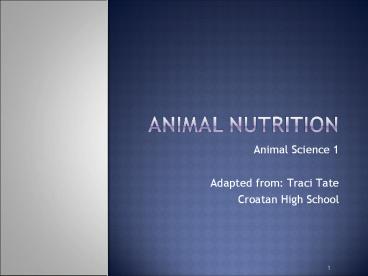Animal Science 1 - PowerPoint PPT Presentation
Title: Animal Science 1
1
- Animal Science 1
- Adapted from Traci Tate
- Croatan High School
1
2
- Major groups of nutrients
- Carbohydrates
- Fats and Oils
- Proteins
- Vitamins
- Minerals
- Water
3
- Main energy nutrients made up of sugars,
starches, cellulose and gums. - Found in the largest quantities in livestock
feed, chemically composed of carbon, hydrogen,
and oxygen. - Main function is to provide energy
4
- 2.25 times the energy of carbohydrates
- At body temperature fats are solid and oils are
liquid
5
- They carry the fat-soluble vitamins.
- Extra carbohydrates are stored as fat.
- Fat is composed of carbon, hydrogen and oxygen.
6
- Organic compounds made up of amino acids.
- Contains carbon, hydrogen, oxygen and nitrogen
- Sometimes sulfur, phosphorus and iron.
7
- Supply material to build body tissues such as
muscles, skin and hair.
Belgian Blue
8
- Trace organic compounds
- Contains carbon
- Helps regulate many body functions
- Designated by letters such as A, B-complex, D, E,
K
9
- A Healthy eyes, conception rate, disease
resistance - B Good bone development
- C Helps teeth and bone formation
- D Produced in animals body when they are in
direct sunlight - Helps with the movement of calcium in the body
- E Muscle Development
- K Helps blood clot
10
- Most vitamins are provided through feed
ingredients - Pre-mixes can be added to feed to balance vitamin
amounts based on the specific needs of the animal
11
- Inorganic materials or compounds needed in small
amounts - Contains no carbon
- Examples Calcium, Phosphorus, Magnesium
12
- Provide material for growth of bones, teeth and
body tissue - Regulate many of the vital chemical body
processes - Provided through most feed ingredients, but
pre-mixes can be added to feed to balance mineral
amounts based on specific needs of the animal.
13
- Makes up to 40 80 of an animals body
- Helps dissolve other nutrients and carry them to
different parts of the body
- A vital factor in nutrition
- Considered by many as the most important nutrient
14
- Carbohydrates
- cereal grains such as corn, wheat, oats, rye,
barley, and sorghum - corn is most commonly used in United States
- Fats and Oils
- grains and protein concentrates
- Regular feed ingredients
15
- Proteins
- plant sources include soybean meal, cottonseed
meal, alfalfa meal and animal sources include
meat meal, fishmeal, dried milk and synthetic
nitrogen source of urea - animal sources fish meal, meat meal, plant
sources soybean meal, cottonseed meal
16
- Vitamins
- most feed ingredients, pre-mixes are added to
feed - Minerals
- most feed ingredients, pre-mixes are added to
feed - mineral blocks
- Water
- usually supplied separate from other nutrients,
liquid form - plumbing, wells
17
- For ruminants, alfalfa hay provides some energy,
protein and high fiber. Molasses can be added to
improve taste (palatability) and reduce feed dust
18
Legume vs. Grass
- Legumes Fix Nitrogen in the soil
- Examples soybeans, alfalfa, clover
- Grasses do not, they take it
- Examples wheat, corn, Fescue
18
19
Roughage vs. Concentrate
- 18 Fiber
- Roughage more than 18 fiber
- Examples Hay, pasture
- Concentrate less than 18 fiber
- Examples grain, supplements
19

